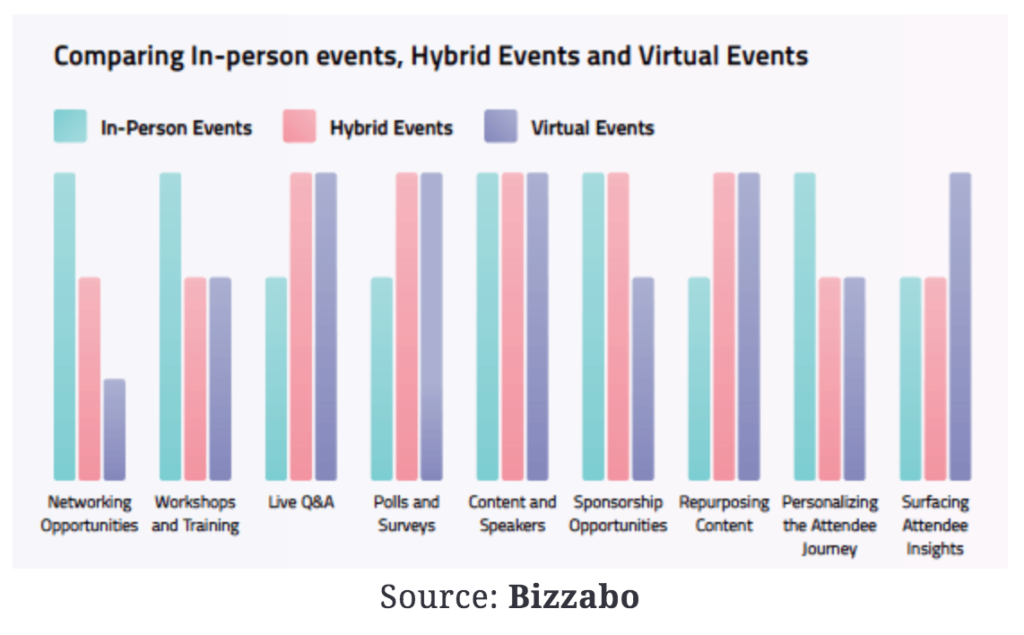Are virtual conferences an efficient alternative or are we not there yet?
While nothing can compare to the power of in-person, unprecedented circumstances have had a major impact on the future of events.
What’s the difference between virtual events and webinars?
Webinars are a valuable channel for connecting with an audience. They can be viewed as one type of virtual event, but they differ from other virtual events in a few key ways.
Uniform vs. Curated
Webinars provide attendees with a single session to attend while virtual events offer flexibility in single-track or multi-track agendas that span across hours or days. Because of this, attendees have the opportunity to curate their own experience and determine which sessions they’d like to attend in a virtual event.
Passive vs. Interactive
Webinars can feature polls, surveys, and Q&As but the majority of webinar interaction is limited to these outlets. Virtual events feature communities where attendees can connect with one another during and in-between sessions. These same community features make it possible for attendees to communicate with speakers and sponsors, as well, as part of the greater event experience. This is in addition to other presentation tools like polls and surveys that are similarly found in webinars.
Similar Experience vs. Unique Experience
Because a virtual attendee has the opportunity to curate their own experience and interact beyond a single session, they are able to carve out a unique event experience. By this same coin, event organizers can better learn about the preferences of their attendees by analyzing their journey across a virtual event. The resulting insights can help organizers send more nuanced follow-up messages to attendees, better tailor both virtual and in-person experiences to their audiences and drive more personalized touchpoints.

Pros and Cons of Virtual Conferences
PROS
Taking your event online can be a real benefit to you and conference participants. Here’s a look at some of the major pros associated with virtual conferences:
- Reduced Overhead
Virtual events save money on overhead expenses like venue, catering, staffing, speakers, presenters, or exhibitors. Attendees will experience savings as well, avoiding transportation, accommodation, and meal costs.
- Possible Lower Entry Free
Because organizers are saving on overhead costs, the savings can be passed on to conference participants. A lower entry fee can mean the event is more accessible to more people, greatly increasing reach and possible revenues.
- More Attractive to Attendees
Travel and hotel costs can be a real obstacle to people who may be interested in your conference. Without having to book flights or a place to stay for multiple nights, a virtual experience can be far more attractive to a far larger number of people.
- Possibility to Create a Content Library
Online events mean you can keep a library of sessions to be accessed at a later date. This means you can provide more value to conference attendees but assuring them that they will never miss a session, meeting, or keynote address. It helps to smooth out any conflicts that can arise in the scheduling process.
- Increased Sponsorship Potential
Sponsorship requests may suddenly become much more appealing! With a larger target audience, sponsorship opportunities increase. And, because there is a greater opportunity to gather data from attendees, sponsorship opportunities become more informative and lucrative.
CONS
There are a few downsides associated with virtual conferences. Here’s a look at some of the primary cons:
- Experience Gap
completely online, virtual events are a brand-new territory for a large number of event planners and organizers. In fact, according to EventMB, only 11.1% of event planners say they have plenty of experience planning virtual events and a whopping 64.3% say they have no experience at all. This means that organizers may need to spend more time educating themselves on best practices and experience some trial and error before getting things perfectly right.
- Must Choose a Provider
When hosting an in-person conference, the presentation of sessions is in the control of the organizer. But, when moving online, it is important to find the right technology platform to ensure that technology is not an obstacle for you or your attendees. Finding the correct fit can feel overwhelming. To help narrow down your options, check out our guide on 14 of the top virtual conference platforms.
In Conclusion
All in all, virtual conferences seem to present various advantages that can’t be ignore. In addition, the innovative factor does have its appeal compared to the more conventional conference model. However, the digital adaptation might not be for all. Numerous conferences rely on “in person” experiences to stimulate the senses and drive the event (a textile conference for example). Thus, it is fair to say that while the innovative approach to virtual conferences is definitely worth keeping an eye on, there is still work to be done before they can be adopted by all.
